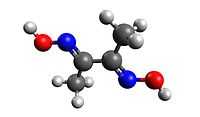Dimethylglyoxime
 | |
 | |
| Names | |
|---|---|
| IUPAC name
Butane-2,3-dione dioxime | |
| Other names
Dimethylglyoxime, Diacetyl dioxime, Chugaev's Reagent | |
| Identifiers | |
| 95-45-4 | |
| ChemSpider | 10606175 |
| |
| Jmol-3D images | Image |
| RTECS number | EK2975000 |
| |
| UNII | 2971MFT1KY |
| Properties | |
| Molecular formula |
C4H8N2O2 |
| Molar mass | 116.12 g·mol−1 |
| Appearance | White/Off White Powder |
| Density | 1.37 g/cm3 |
| Melting point | 240 °C (464 °F; 513 K) |
| Boiling point | decomposes |
| low | |
| Structure | |
| Dipole moment | 0 |
| Hazards | |
| MSDS | External MSDS |
| Main hazards | Toxic, Skin/Eye Irritant |
| R-phrases | R20/22 |
| S-phrases | R22, R36/37 |
| NFPA 704 | |
| Related compounds | |
| Related compounds |
Hydroxylamine salicylaldoxime |
| Except where noted otherwise, data is given for materials in their standard state (at 25 °C (77 °F), 100 kPa) | |
| | |
| Infobox references | |
Dimethylglyoxime is a chemical compound described by the formula CH3C(NOH)C(NOH)CH3. This colourless solid is the dioxime derivative of the diketone butane-2,3-dione (also known as diacetyl). DmgH2 is used in the analysis of palladium or nickel. Its coordination complexes are of theoretical interest as models for enzymes and as catalysts. Many related ligands can be prepared from other diketones, e.g. benzil.
Preparation
Dimethylglyoxime can be prepared from butanone first by reaction with ethyl nitrite followed by sodium hydroxylamine monosulfonate:[1]
Ni(dmgH)2
Dimethylglyoxime is used as a chelating agent in the gravimetric analysis of nickel:
 A sample of Ni(dmgH)2
A sample of Ni(dmgH)2
The use of DMG as a reagent to detect nickel was discovered by L. A. Chugaev in 1905.[2] For qualitative analysis, dmgH2 is often used as a solution in ethanol. It is the conjugate base, not dmgH2 itself, that forms the complexes. Furthermore, a pair of dmgH− ligands are joined through hydrogen bonds to give a macrocyclic ligand. The most famous complex is the bright red Ni(dmgH)2, formed by treatment of Ni(II) sources with dmgH2. This planar complex is very poorly soluble and so precipitates from solution. This method is used for the gravimetric determination of nickel, e.g. in ores.
Cobaloximes
The nitrogen atoms in dmgH2 and its complexes are sp2 hybridized.[3] Because of the planarity of the resulting ligand, the macrocycle [dmgH]22− resembles some biologically important macrocyclic ligands, as found for example in vitamin B12 and myoglobin. A well known family of model complexes, the cobaloximes, have the formula CoR(dmgH)2L, where R is an alkyl group and L is typically pyridine. In such complexes, L and R occupy “axial” positions on the cobalt, perpendicular to the plane of the (dmgH)2. One of the examples of cobaloxime is chloro(pyridine)cobaloxime.
cobaloxime_fixed.png) Structure of chloro(pyridine)cobaloxime
Structure of chloro(pyridine)cobaloximecobaloxime(III).jpg) Sample of chloro(pyridine)cobaloxime
Sample of chloro(pyridine)cobaloxime
References
- ↑ Semon, W. L.; Damerell, V. R. (1943). "Dimethylglyoxime". Org. Synth.; Coll. Vol. 2, p. 204
- ↑ Lev Tschugaeff (1905). "Über ein neues, empfindliches Reagens auf Nickel". Berichte der deutschen chemischen Gesellschaft 38 (3): 2520–2522. doi:10.1002/cber.19050380317.
- ↑ Girolami, G.. S.; Rauchfuss, T.B.; Angelici, R. J. (1999). Synthesis and Technique in Inorganic Chemistry: A Laboratory Manual (3rd ed.). pp. 213–215.

